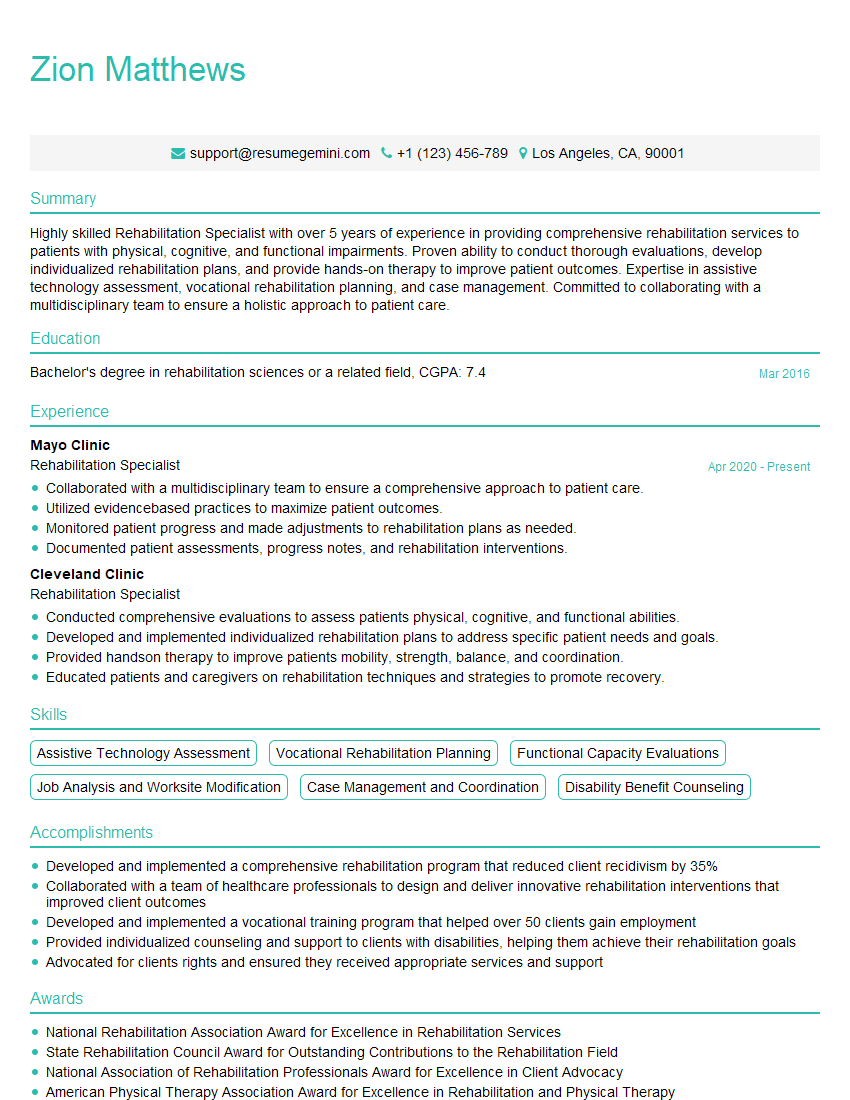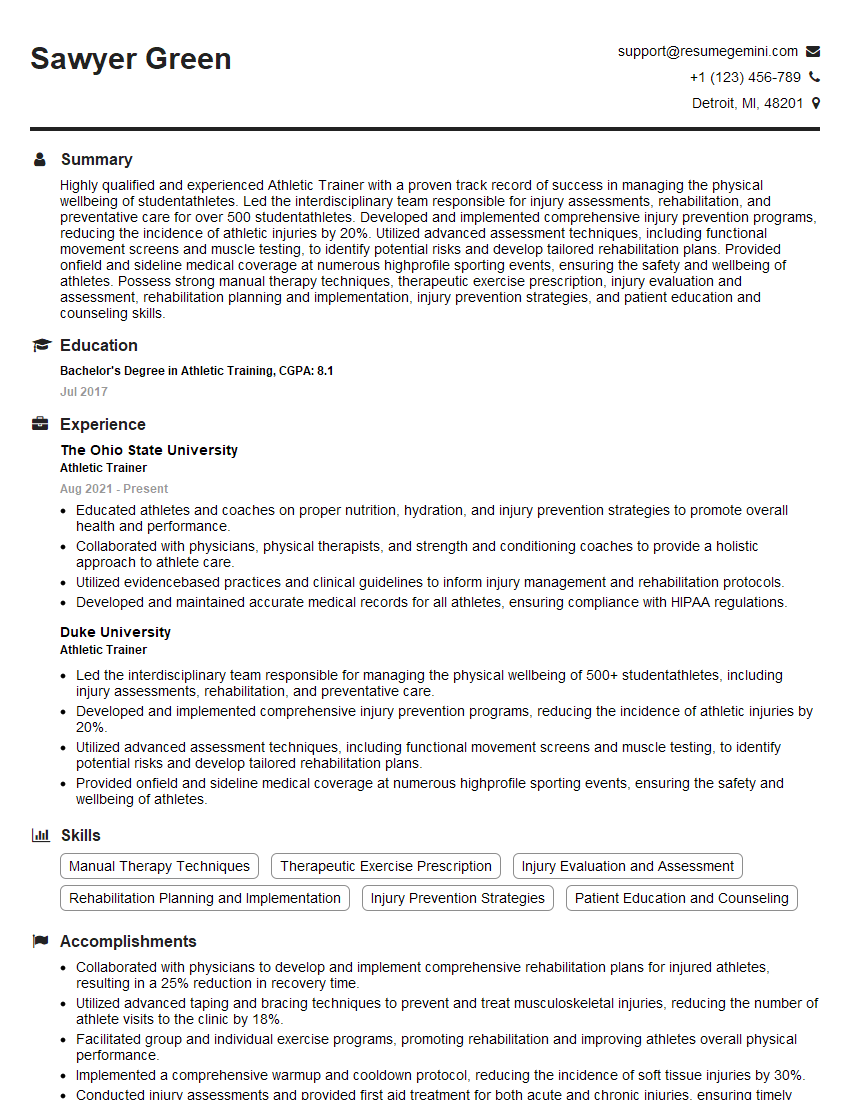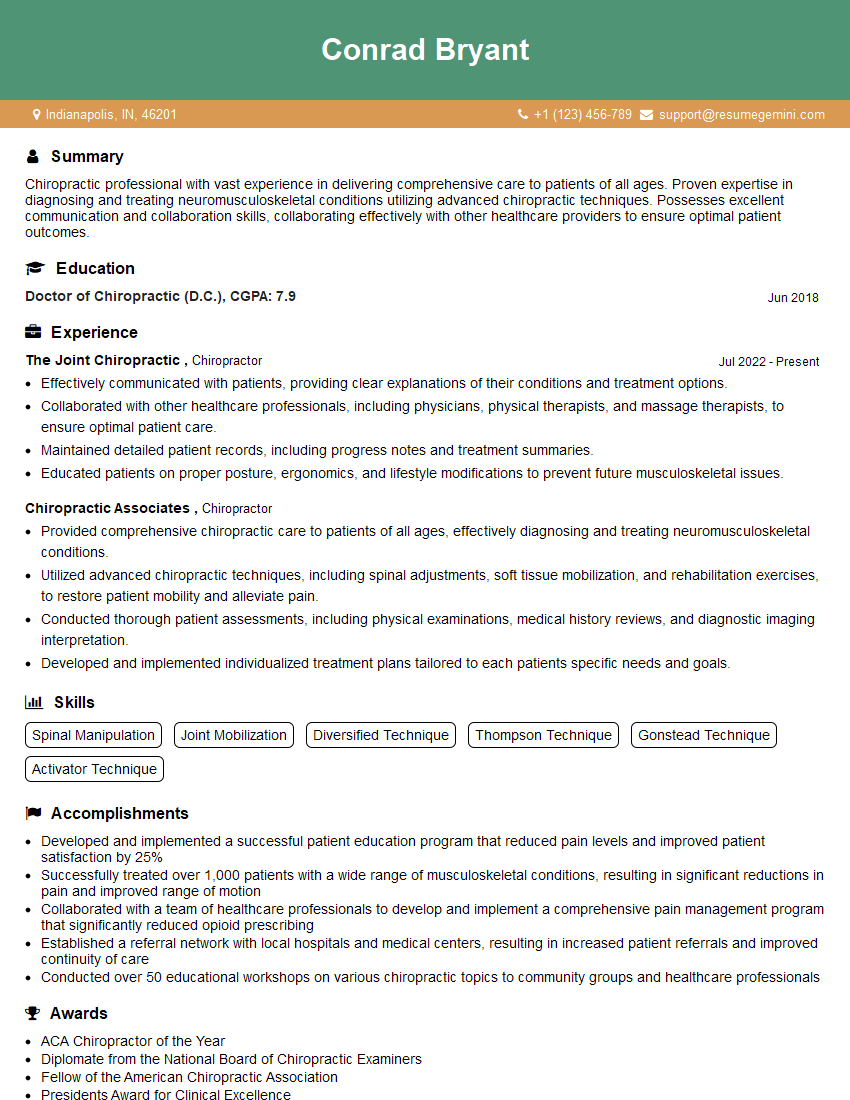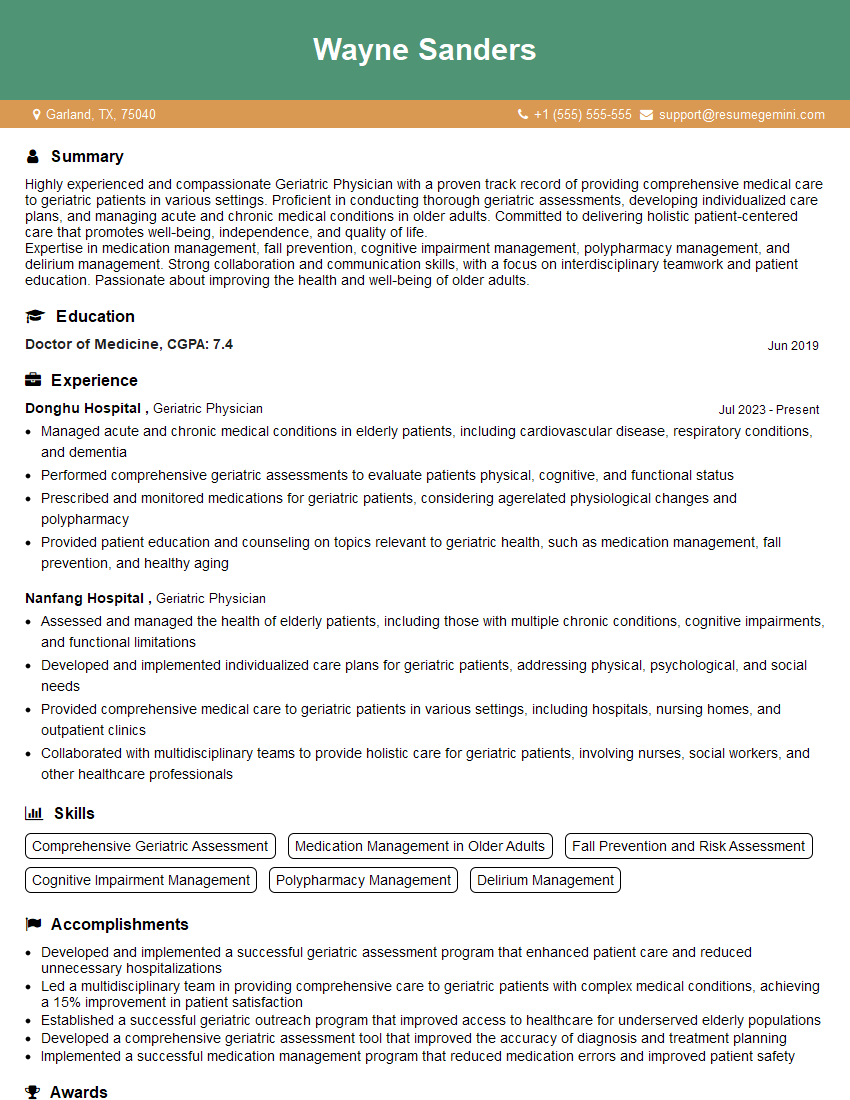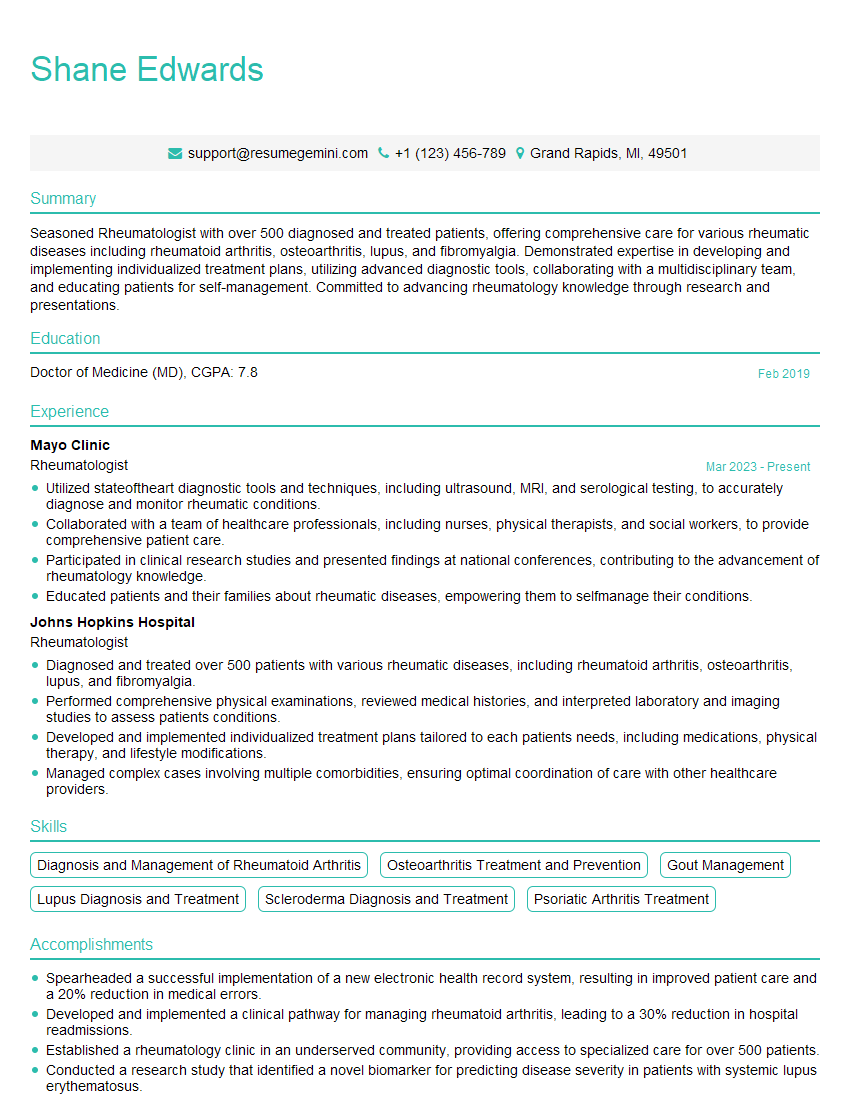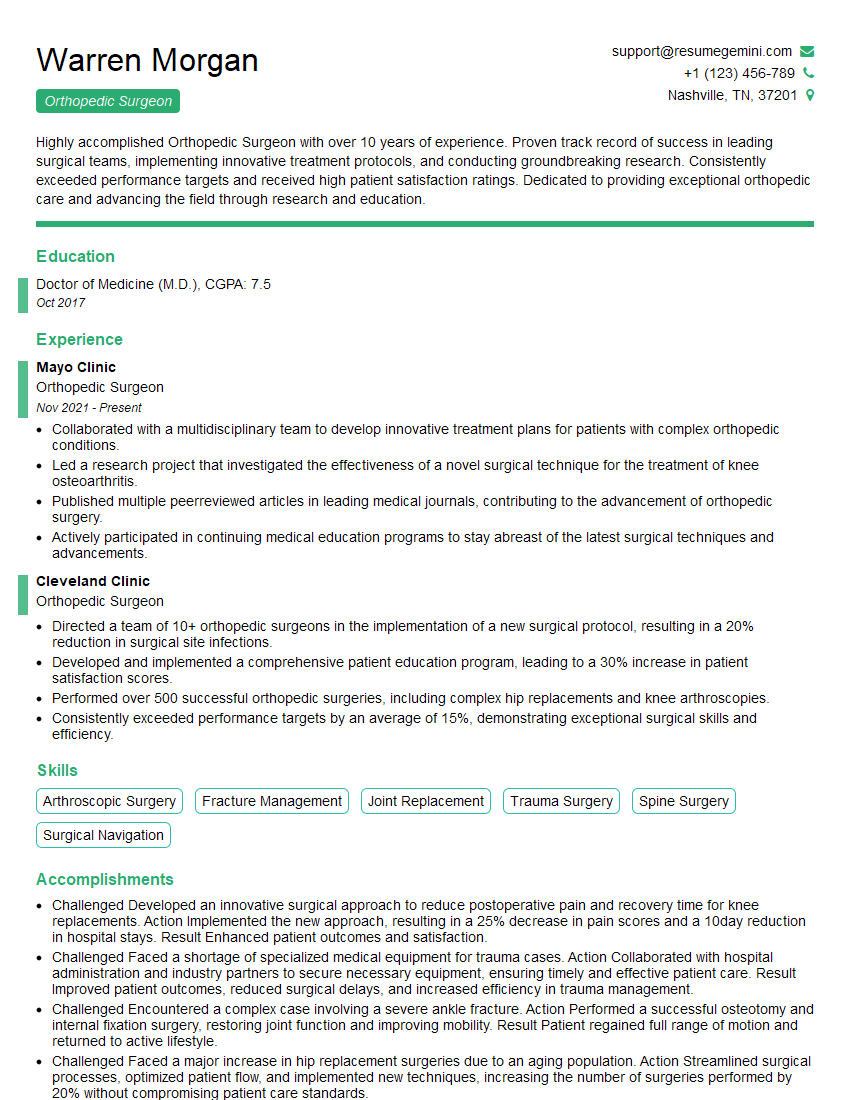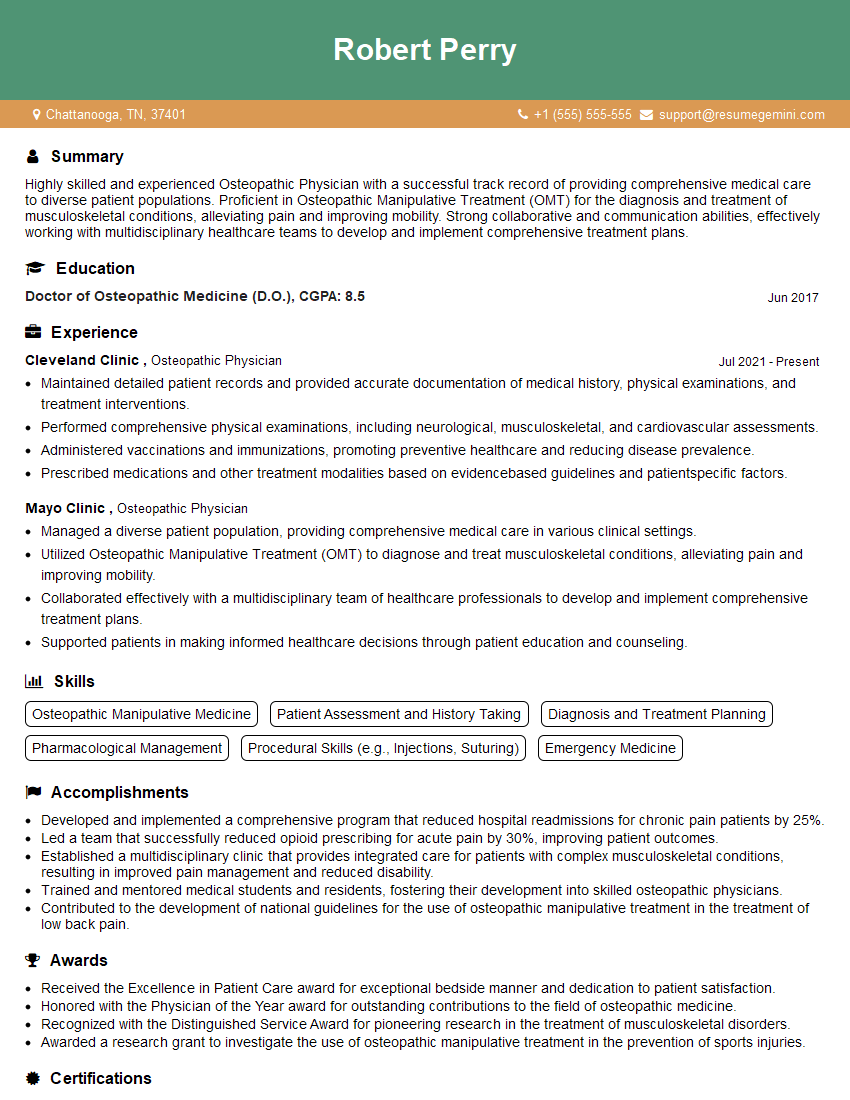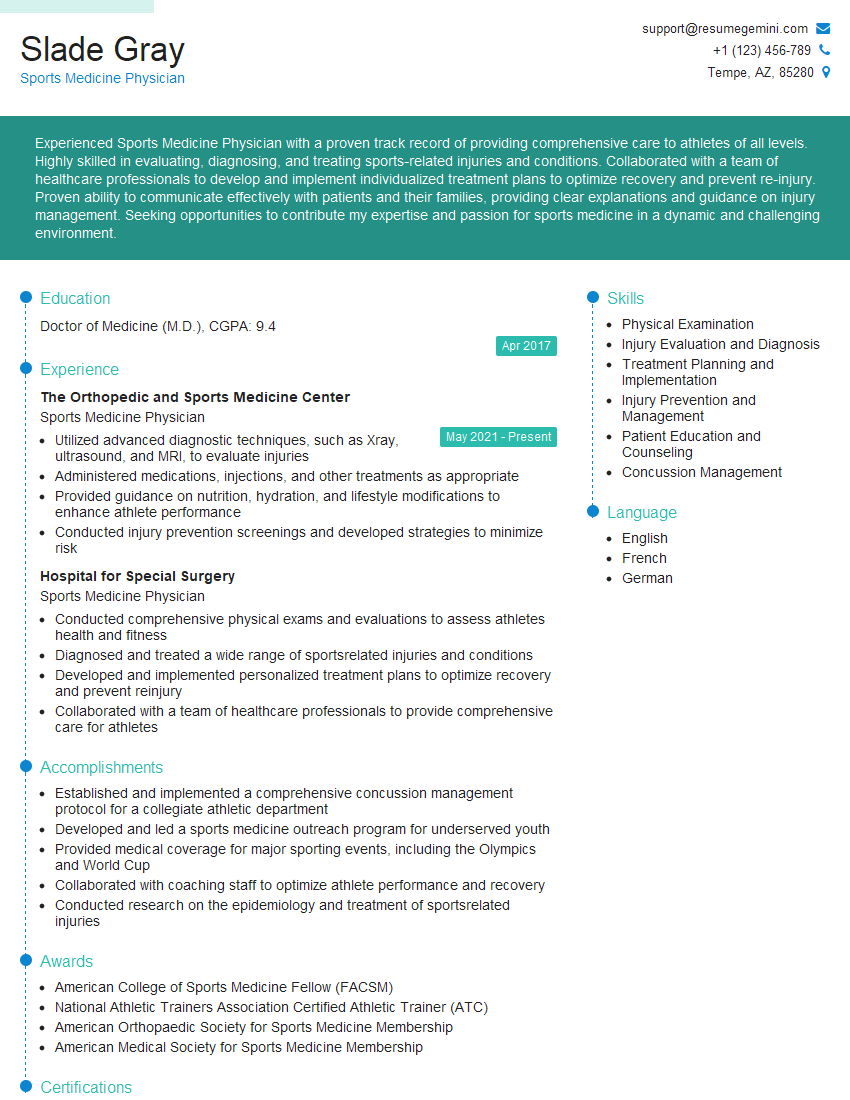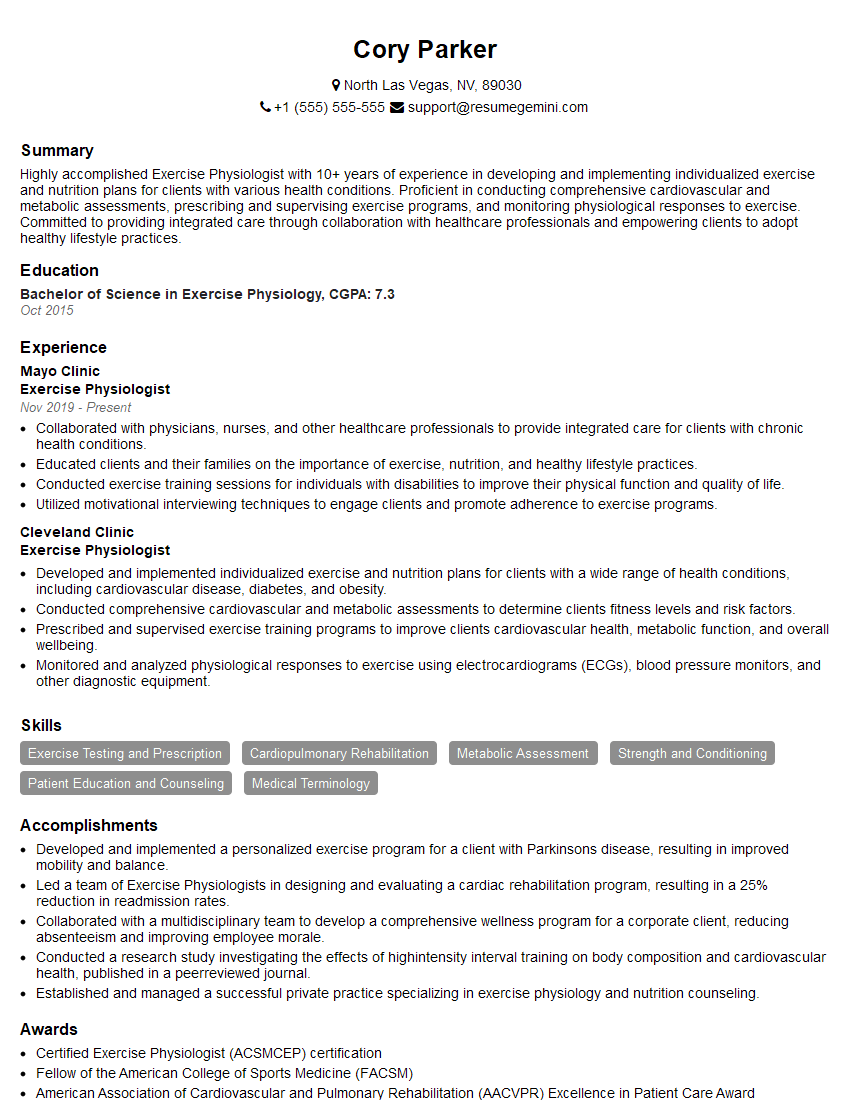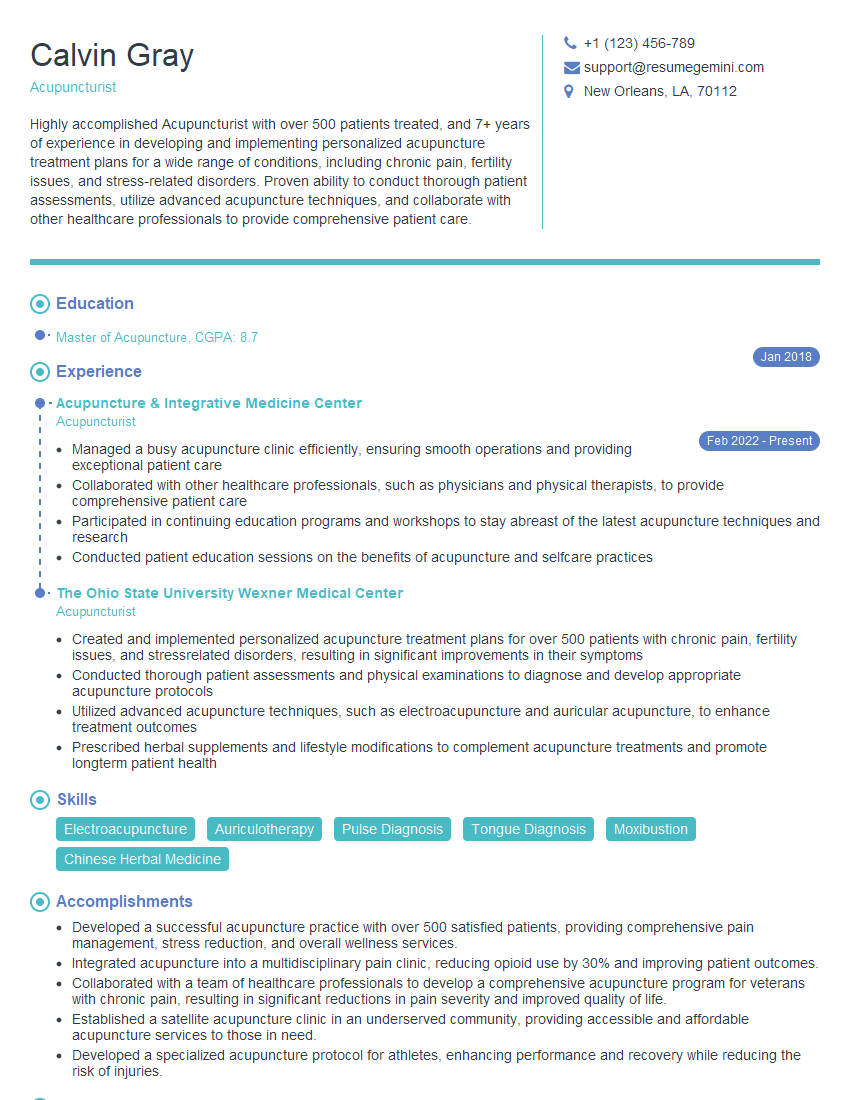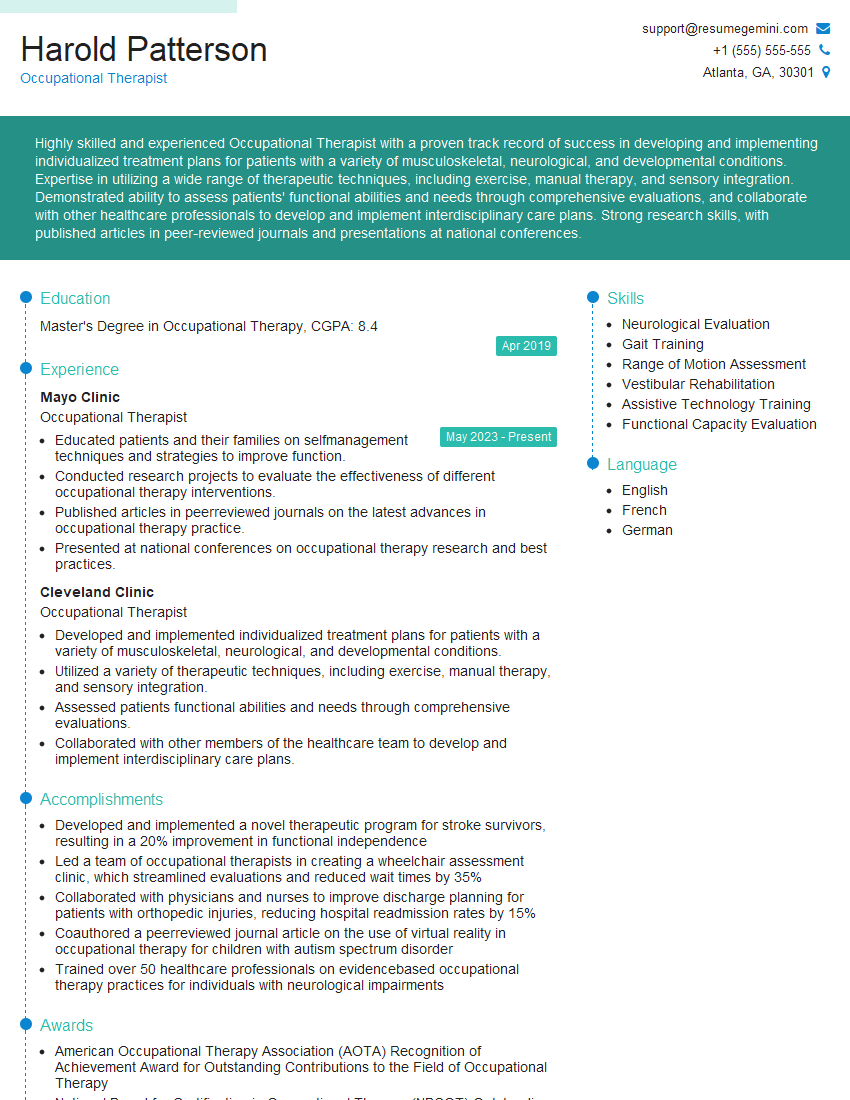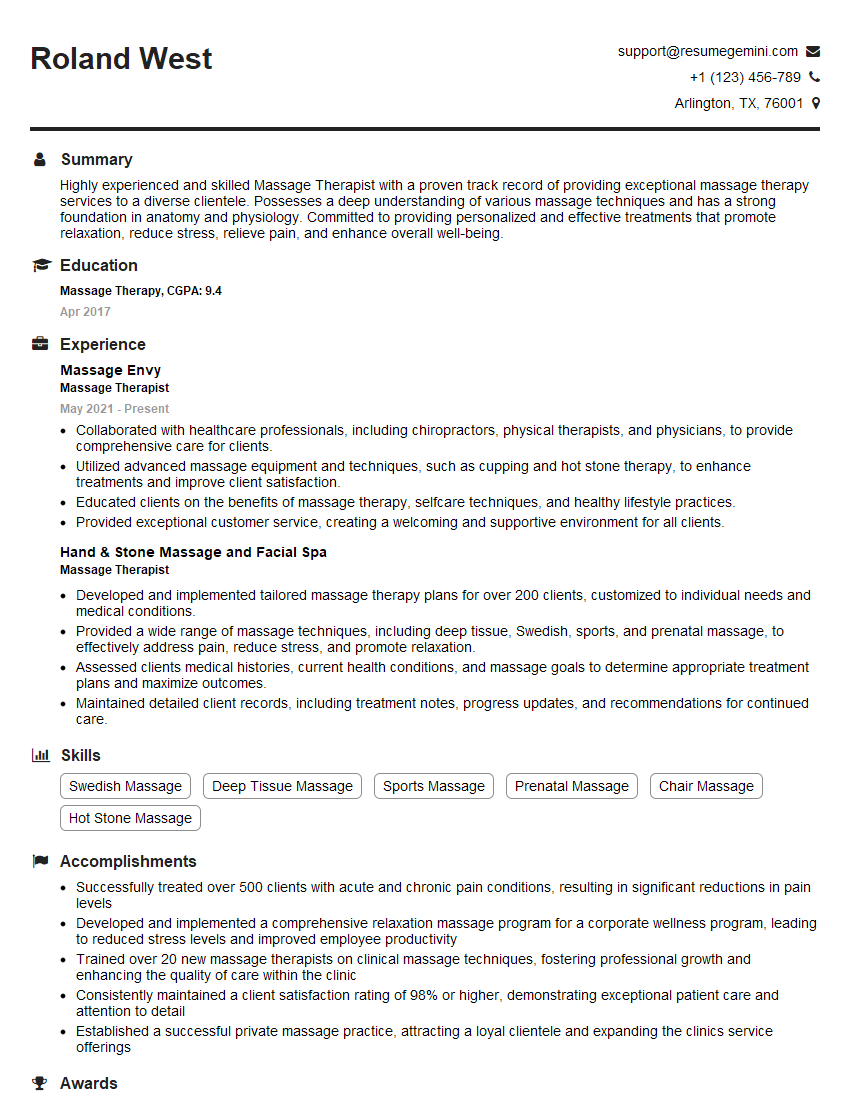Every successful interview starts with knowing what to expect. In this blog, we’ll take you through the top Osteoarthritis Treatment and Prevention interview questions, breaking them down with expert tips to help you deliver impactful answers. Step into your next interview fully prepared and ready to succeed.
Questions Asked in Osteoarthritis Treatment and Prevention Interview
Q 1. Describe the pathophysiology of osteoarthritis.
Osteoarthritis (OA), also known as degenerative joint disease, is a chronic condition characterized by the progressive breakdown of cartilage in the joints. The pathophysiology is complex and multifactorial, but essentially involves a disruption of the delicate balance between cartilage synthesis and degradation. Think of cartilage as the cushion between your bones – in OA, this cushion wears down.
Several key processes contribute:
- Cartilage Degradation: Enzymes called matrix metalloproteinases (MMPs) and aggrecanases break down the cartilage matrix, leading to its thinning and eventual loss. This is exacerbated by inflammation and mechanical stress.
- Chondrocyte Dysfunction: Chondrocytes are the cells responsible for producing and maintaining cartilage. In OA, these cells become dysfunctional, producing less cartilage and releasing inflammatory mediators.
- Subchondral Bone Changes: The bone underlying the cartilage (subchondral bone) undergoes changes, including sclerosis (increased density) and cyst formation. This can lead to pain and further joint instability.
- Synovitis: Inflammation of the synovial membrane, the lining of the joint, contributes to pain and joint swelling. This inflammation isn’t always present in the early stages, but often becomes a key feature of advanced OA.
- Genetic Factors: Genetic predisposition plays a role, influencing susceptibility to cartilage degradation and inflammation.
In essence, OA is a vicious cycle: cartilage breakdown leads to increased stress on the joint, which further accelerates cartilage degradation and inflammation.
Q 2. Explain the role of inflammation in osteoarthritis progression.
Inflammation plays a crucial role in the progression of osteoarthritis, although its exact contribution is still being explored. While OA is often considered a non-inflammatory condition in its early stages, inflammation becomes increasingly important as the disease progresses.
The inflammatory process in OA involves various cells and molecules:
- Synovial Inflammation: The synovial membrane, surrounding the joint, becomes inflamed, producing pro-inflammatory cytokines (e.g., TNF-alpha, IL-1β, IL-6) and chemokines that attract immune cells.
- Chondrocyte Inflammation: Chondrocytes themselves can become inflammatory, contributing to cartilage breakdown.
- Subchondral Bone Inflammation: Inflammation in the subchondral bone can stimulate further bone remodeling and contribute to pain.
- Oxidative Stress: Increased levels of reactive oxygen species contribute to cartilage damage and inflammation.
The inflammatory process promotes cartilage breakdown, bone remodeling, and pain perception, thus accelerating OA progression. This is why anti-inflammatory strategies, both pharmacological and non-pharmacological, are vital in managing OA.
Q 3. What are the common clinical manifestations of osteoarthritis?
The clinical manifestations of osteoarthritis vary depending on the affected joint and disease severity. Common symptoms include:
- Joint Pain: Typically worse after activity and relieved by rest. The pain is often described as aching or stiffness.
- Joint Stiffness: More pronounced in the morning or after periods of inactivity. This stiffness often improves after movement.
- Crepitus: A grating or crackling sensation felt or heard during joint movement, caused by the roughening of cartilage surfaces.
- Limited Range of Motion: Difficulty moving the affected joint through its normal range of movement.
- Joint Swelling: Can occur due to inflammation or fluid accumulation in the joint.
- Deformity: In advanced stages, joint deformity (e.g., bony enlargements, joint instability) may develop.
Symptoms can vary significantly between individuals, and some individuals may have minimal symptoms despite significant radiographic changes. The location of OA will also impact symptom manifestation; OA of the knee, for example, often leads to gait disturbances and reduced mobility, unlike OA in the hands which primarily causes pain and stiffness.
Q 4. Discuss the diagnostic criteria for osteoarthritis.
Diagnosis of osteoarthritis relies on a combination of clinical findings and imaging studies. There isn’t one single definitive test. The American College of Rheumatology (ACR) has proposed criteria, but they are not universally accepted as the sole diagnostic tool. Key aspects include:
- History and Physical Examination: A thorough assessment of symptoms, including pain location, duration, and character, is crucial. Physical examination focuses on joint tenderness, range of motion, and detection of crepitus.
- Imaging Studies (X-rays): X-rays remain the primary imaging modality for OA diagnosis, revealing features such as joint space narrowing, osteophytes (bone spurs), and subchondral sclerosis.
- Exclusion of other conditions: It’s crucial to rule out other conditions that can mimic OA, such as rheumatoid arthritis, inflammatory arthritis, and septic arthritis.
Clinicians typically use a combination of these elements to make a diagnosis of OA. The ACR criteria help guide the diagnostic process but aren’t strictly adhered to as an absolute diagnostic test.
Q 5. What imaging techniques are used to diagnose osteoarthritis?
Several imaging techniques are used to diagnose and assess the severity of osteoarthritis:
- X-rays: The most commonly used method. X-rays reveal structural changes in the joint, including joint space narrowing, osteophytes (bone spurs), subchondral sclerosis (increased bone density), and cysts.
- Ultrasound: Can visualize synovial inflammation and effusions (fluid accumulation) in the joint, which are not always visible on X-rays. It can also assess cartilage thickness and quality.
- MRI (Magnetic Resonance Imaging): Provides highly detailed images of the joint structures, including cartilage, bone, and synovium. MRI is particularly useful in evaluating cartilage health and the presence of bone marrow edema (bone bruising), which can be indicators of early or active OA.
- CT (Computed Tomography): Less frequently used for OA, but it can provide detailed images of bone and can be helpful in assessing bone spurs and other bony changes.
The choice of imaging technique depends on the clinical context and the information needed. For initial diagnosis, X-rays are usually sufficient, but MRI may be useful for more detailed assessment or in cases where the diagnosis is uncertain.
Q 6. Outline the non-pharmacological management strategies for osteoarthritis.
Non-pharmacological management forms the cornerstone of osteoarthritis treatment, particularly in the early stages of the disease. These strategies aim to reduce pain, improve function, and slow disease progression. They include:
- Weight Management: Losing weight, if overweight or obese, significantly reduces stress on weight-bearing joints like the knees and hips.
- Exercise: Regular low-impact exercise, such as walking, swimming, or cycling, strengthens muscles, improves joint stability, and reduces pain. Specific exercises can be tailored to target specific joint issues.
- Physical Therapy: A physical therapist can provide guidance on exercise programs, teach joint protection techniques, and provide manual therapy (e.g., joint mobilization) to improve range of motion and reduce pain.
- Assistive Devices: Walking aids (canes, walkers), orthotics (shoe inserts), and splints can help support joints and improve mobility.
- Occupational Therapy: Occupational therapy can help individuals adapt their work and daily activities to reduce stress on affected joints and improve functional ability.
- Education and Self-Management: Patients need to be educated about their condition, and self-management strategies, such as activity modification and joint protection techniques are crucial for long term management.
A multidisciplinary approach, involving the patient, physician, physical therapist, and occupational therapist, often leads to the best outcomes.
Q 7. Detail the pharmacological treatment options for osteoarthritis pain relief.
Pharmacological treatment options for osteoarthritis focus on pain relief and inflammation management. The choice of medication depends on the severity of symptoms and individual patient factors.
- Acetaminophen (Paracetamol): A commonly used first-line analgesic (pain reliever). It’s generally well-tolerated but has limited anti-inflammatory effects.
- Nonsteroidal Anti-inflammatory Drugs (NSAIDs): Such as ibuprofen, naproxen, and diclofenac. NSAIDs effectively reduce both pain and inflammation, but they can have side effects, particularly gastrointestinal problems and cardiovascular issues. Therefore, careful consideration of benefits and risks is essential.
- Topical NSAIDs: These NSAIDs are applied directly to the affected joint and can provide localized pain and inflammation relief with fewer systemic side effects compared to oral NSAIDs.
- Intra-articular Corticosteroid Injections: Corticosteroids, injected directly into the joint, provide rapid pain relief and reduce inflammation but should only be used intermittently due to potential risks associated with long-term use.
- Hyaluronic Acid Injections: Hyaluronic acid injections are viscous solutions that can lubricate the joint, potentially improving pain and function. The evidence of their efficacy isn’t as robust compared to other treatments.
- Disease Modifying Osteoarthritis Drugs (DMOADs): There are currently no drugs approved as DMOADs that directly modify OA disease progression. This is an active area of research.
It’s important to note that each pharmacological treatment has potential side effects, and close monitoring is needed, especially when using NSAIDs. Patients should consult their doctor before starting any new medication for OA.
Q 8. Explain the benefits and risks of NSAIDs in osteoarthritis.
Nonsteroidal anti-inflammatory drugs (NSAIDs) are commonly used to manage osteoarthritis pain and inflammation. They work by inhibiting the production of prostaglandins, chemicals that contribute to pain and swelling.
Benefits: NSAIDs are readily available, relatively inexpensive, and can provide effective pain relief and reduce inflammation, allowing for improved mobility and function. Many are available over-the-counter.
Risks: However, NSAIDs carry significant risks, especially with long-term use. These include gastrointestinal issues like ulcers and bleeding, increased risk of heart attack and stroke, kidney problems, and liver damage. Some individuals may also experience allergic reactions. Therefore, NSAIDs should be used cautiously, under the guidance of a physician, and at the lowest effective dose for the shortest duration possible. Regular monitoring for side effects is crucial. For example, a patient with a history of stomach ulcers should be particularly careful when considering NSAIDs, possibly needing a protective medication like a proton pump inhibitor.
Q 9. Discuss the role of corticosteroids in osteoarthritis management.
Corticosteroids, powerful anti-inflammatory medications, are injected directly into the affected joint in osteoarthritis. This targeted approach delivers high concentrations of medication to the area needing it most, achieving rapid and significant reduction in pain and inflammation.
Role: Corticosteroid injections are typically used for short-term symptom relief, particularly during flare-ups of osteoarthritis. They aren’t a long-term solution due to potential side effects and the risk of joint damage with repeated injections. They provide a ‘bridge’ while other treatments take effect, or for patients needing immediate relief before starting a longer-term management plan. Think of them like a temporary fix for a particularly painful episode.
Limitations: Frequent injections can lead to joint instability, thinning of cartilage, and increased risk of infection. Therefore, they’re generally reserved for a limited number of injections per year, typically no more than three to four in any given joint within a 12-month period.
Q 10. Describe the use of viscosupplementation in osteoarthritis treatment.
Viscosupplementation involves injecting hyaluronic acid (HA) into the affected joint. Hyaluronic acid is a naturally occurring substance that lubricates and cushions joints. In osteoarthritis, the natural HA content is reduced, leading to increased friction and pain.
Use: Viscosupplementation aims to replenish the HA, improving joint lubrication and reducing pain and stiffness. It’s typically considered for patients with mild to moderate osteoarthritis who haven’t responded well to other conservative treatments. The effects are usually not immediate and it can take several weeks to see significant improvement. It is a good option for patients who prefer to avoid or delay surgery and are looking for a longer-term solution than corticosteroids.
Example: A patient with knee osteoarthritis who experiences significant pain and stiffness despite physical therapy and over-the-counter pain relievers might benefit from viscosupplementation.
Q 11. Explain the indications for surgical intervention in osteoarthritis.
Surgical intervention for osteoarthritis is generally considered when conservative treatments (medication, physiotherapy, lifestyle changes) have failed to provide adequate pain relief and functional improvement. The decision is based on the severity of the disease, the impact on daily activities, and the patient’s overall health and preferences.
Indications: Severe pain, significant joint deformity, inability to perform daily activities, and failure of conservative management are all strong indications for surgery. For example, a patient experiencing persistent and debilitating knee pain despite trying various conservative approaches, severely limiting their ability to walk or climb stairs, might be a suitable candidate for a total knee replacement.
Q 12. What are the different types of joint replacement surgeries for osteoarthritis?
The most common types of joint replacement surgeries for osteoarthritis are arthroplasties (joint replacement surgeries). These include:
- Total Joint Replacement (Arthroplasty): This involves replacing the entire damaged joint with an artificial implant, made typically of metal and plastic components. Total knee replacement (TKR) and total hip replacement (THR) are the most common examples.
- Partial Joint Replacement (Unicompartmental Arthroplasty): This is a less invasive procedure suitable for patients with damage restricted to only one compartment of the joint. It’s often used in the knee when only one section of the knee joint is significantly affected.
- Osteotomy: This surgery involves reshaping the bone to shift weight away from the damaged joint surface. It’s often considered a less invasive alternative to total joint replacement in younger patients with early-stage arthritis.
Q 13. Discuss the post-operative care for patients undergoing joint replacement surgery.
Post-operative care following joint replacement is crucial for successful recovery and long-term outcome. It is a multi-faceted process including:
- Pain Management: Post-operative pain is usually managed with medication, often a combination of opioids and non-opioids in the early stages, gradually transitioning to non-opioid analgesics.
- Physical Therapy: A comprehensive physical therapy program is essential to regain joint mobility, strength, and functional independence. This typically involves range-of-motion exercises, strengthening exercises, and gait training.
- Infection Prevention: Strict adherence to infection control measures, including wound care and antibiotic prophylaxis, is critical to prevent potentially devastating complications. This includes regular wound checks and the appropriate use of antibiotics.
- Weight Management: Maintaining a healthy weight reduces stress on the new joint and improves long-term outcomes. This involves dietary changes, and an increase in physical activity after the initial recovery phase.
- Follow-up Appointments: Regular follow-up appointments with the orthopedic surgeon and physical therapist are necessary for monitoring progress, addressing any complications, and adjusting the rehabilitation plan as needed.
For instance, a patient undergoing TKR would typically spend several days in the hospital, followed by weeks of intensive physical therapy, and ongoing rehabilitation for several months.
Q 14. Explain the importance of patient education in osteoarthritis management.
Patient education plays a pivotal role in successful osteoarthritis management. Empowered patients are better equipped to actively participate in their care and make informed decisions. Effective education should cover:
- Understanding Osteoarthritis: Providing clear explanations of the disease process, its causes, and its potential progression.
- Treatment Options: Discussing the various treatment options, including medications, therapies, and surgical interventions, highlighting their benefits, risks, and suitability for individual needs.
- Lifestyle Modifications: Emphasizing the importance of weight management, regular exercise (appropriate to the condition), joint protection techniques, and assistive devices as needed.
- Self-Management Strategies: Equipping patients with the knowledge and skills to manage their pain and symptoms effectively, including pain management techniques, pacing activities, and recognizing warning signs of complications.
- Resources and Support: Directing patients to reliable sources of information and support groups, connecting them with other patients who have gone through similar experiences.
For example, educating a patient on the benefits of low-impact exercise, such as swimming or cycling, can help manage weight, improve strength, and reduce joint stress, significantly improving their quality of life.
Q 15. How do you assess a patient’s functional capacity in osteoarthritis?
Assessing a patient’s functional capacity in osteoarthritis involves understanding their ability to perform daily activities. We use a combination of methods to get a complete picture. This isn’t just about how much pain they’re in, but how that pain limits their daily life.
Patient Reported Outcome Measures (PROMs): These questionnaires, like the Western Ontario and McMaster Universities Osteoarthritis Index (WOMAC) or the Knee injury and Osteoarthritis Outcome Score (KOOS), provide quantitative data on pain, stiffness, and functional limitations from the patient’s perspective. For example, a WOMAC score can help us track changes over time, showing us whether treatment is effective.
Performance-Based Assessments: These involve directly observing the patient performing specific tasks, such as walking a certain distance, rising from a chair, or climbing stairs. We time these activities and look for gait abnormalities or compensations. For example, we might observe how many times a patient uses a handrail while climbing stairs, indicating reliance on assistance.
Physical Examination: This includes a detailed assessment of joint range of motion, muscle strength, and any deformities. We’re looking for signs of muscle atrophy or weakness which could contribute to functional limitations. This can help tailor an exercise program to specifically address those weaknesses.
By combining these methods, we create a holistic picture of the patient’s functional capacity and tailor treatment accordingly. For example, a patient with severely limited mobility may benefit from assistive devices and a more gradual exercise program, while a patient with milder limitations might benefit from more intense physical therapy.
Career Expert Tips:
- Ace those interviews! Prepare effectively by reviewing the Top 50 Most Common Interview Questions on ResumeGemini.
- Navigate your job search with confidence! Explore a wide range of Career Tips on ResumeGemini. Learn about common challenges and recommendations to overcome them.
- Craft the perfect resume! Master the Art of Resume Writing with ResumeGemini’s guide. Showcase your unique qualifications and achievements effectively.
- Don’t miss out on holiday savings! Build your dream resume with ResumeGemini’s ATS optimized templates.
Q 16. Describe your approach to managing osteoarthritis in elderly patients.
Managing osteoarthritis in elderly patients requires a multifaceted approach, prioritizing safety and considering the individual’s overall health. We need to balance the need for effective pain management with the potential for adverse effects from medications.
Non-Pharmacological Interventions: These should form the cornerstone of our strategy. This includes regular, low-impact exercise such as walking, swimming or cycling; tailored physical therapy focusing on strengthening and range of motion; and assistive devices like canes or walkers to improve mobility and reduce pain. Weight management is crucial, especially if obesity is a contributing factor.
Pharmacological Interventions: We start with non-opioid analgesics like acetaminophen or NSAIDs. Opioids are generally avoided due to the increased risk of falls and side effects in this population. Topical NSAIDs or capsaicin creams can provide localized pain relief. We carefully monitor for side effects and adjust the treatment accordingly. The use of topical NSAIDs would help alleviate pain without the systematic side effects of oral NSAIDs.
Patient Education: A vital aspect is educating the patient about their condition, self-management strategies, and the importance of adherence to treatment plans. Regular check-ins to discuss progress and address concerns are essential.
Multidisciplinary Approach: Often, elderly patients with osteoarthritis also have other health conditions (comorbidities). Collaborating with other specialists such as geriatricians, cardiologists, or other healthcare professionals is vital for comprehensive care.
For instance, an elderly patient with both osteoarthritis and heart conditions would require careful medication selection to avoid drug interactions and potential cardiovascular complications.
Q 17. How do you address comorbidities in patients with osteoarthritis?
Addressing comorbidities in osteoarthritis patients is crucial because these conditions often interact and influence treatment options. For example, diabetes can affect wound healing, making it more difficult to manage post-surgical complications.
Comprehensive Assessment: We need to identify and thoroughly assess all existing conditions. This might include reviewing medical records, conducting physical exams, and ordering relevant laboratory tests. An example would be checking blood sugar levels in a patient with suspected diabetes.
Individualized Treatment Plans: Treatment plans must consider potential interactions between medications for osteoarthritis and those for other conditions. For example, NSAIDs can increase the risk of gastrointestinal bleeding in patients taking anticoagulants.
Multidisciplinary Care: Often, effective management involves collaborating with other healthcare professionals like cardiologists, endocrinologists, or pulmonologists, depending on the specific comorbidities. A patient with osteoarthritis and heart failure might require a cardiologist’s input to ensure that exercise regimens are safe.
Medication Management: We need to carefully select medications with the fewest potential interactions and side effects. We might choose medications with a lower risk of gastrointestinal bleeding or renal impairment, particularly in patients with existing kidney issues.
By taking a holistic approach, we can improve patient outcomes and prevent complications.
Q 18. What are the risk factors for osteoarthritis development?
Osteoarthritis development is a complex process influenced by several factors. Some are modifiable, meaning we can change them, while others are non-modifiable (we can’t change them).
Non-Modifiable Risk Factors:
- Age: The risk increases significantly with age.
- Sex: Women are more likely to develop osteoarthritis, particularly in the hands and knees.
- Genetics: A family history of osteoarthritis increases the risk.
Modifiable Risk Factors:
- Obesity: Excess weight places increased stress on weight-bearing joints like hips and knees.
- Joint Injury: Previous injuries, such as fractures or ligament tears, can increase the risk of developing osteoarthritis in the affected joint later in life.
- Occupation: Repetitive joint loading or heavy physical labor can contribute to osteoarthritis development.
- Physical Inactivity: Lack of exercise weakens supporting muscles, making joints more prone to injury and deterioration.
Understanding these risk factors allows us to focus preventative strategies on those that are modifiable, such as promoting weight management, encouraging physical activity, and educating individuals about joint protection techniques.
Q 19. Explain the role of physical therapy in osteoarthritis treatment.
Physical therapy plays a vital role in osteoarthritis management, focusing on improving function and reducing pain. It’s not just about treating symptoms; it’s about empowering patients to manage their condition effectively.
Exercise Therapy: A tailored exercise program is critical. This usually involves a combination of aerobic exercises to improve cardiovascular health and muscle strength, and range-of-motion exercises to maintain joint flexibility. Exercises should be low-impact, focusing on strengthening the muscles surrounding the affected joints to support them.
Manual Therapy: Techniques like joint mobilization and soft tissue massage can help improve joint range of motion and reduce pain. These techniques are performed by trained physical therapists to improve joint mobility and reduce muscle stiffness.
Functional Training: This focuses on improving the patient’s ability to perform daily activities, such as walking, climbing stairs, or getting up from a chair. This practical approach translates directly to improved quality of life.
Patient Education: Physical therapists educate patients about proper body mechanics, joint protection techniques, and activity modification to reduce stress on affected joints. This empowerment of self-management is crucial for long-term success.
For example, a patient with knee osteoarthritis might benefit from exercises to strengthen the quadriceps muscles, which provide crucial support for the knee. This proactive approach helps patients gain functional independence and improve their quality of life.
Q 20. Discuss the importance of weight management in osteoarthritis prevention.
Weight management is paramount in osteoarthritis prevention, particularly for weight-bearing joints. Excess weight increases the stress and load on these joints, accelerating cartilage breakdown and promoting inflammation.
Reduced Joint Stress: Losing even a small amount of weight can significantly reduce the load on the knees, hips, and ankles, relieving pain and slowing the progression of osteoarthritis. This is like reducing the weight carried by a truck’s axle: less weight means less wear and tear.
Improved Physical Function: Weight loss improves overall physical fitness, enabling increased activity levels without excessive joint strain. This allows for participation in low-impact exercise which is beneficial for joint health.
Reduced Inflammation: Obesity is linked to systemic inflammation, which plays a significant role in osteoarthritis progression. Weight loss can help reduce this inflammation, protecting joint cartilage. This helps decrease the body’s overall inflammatory response that can exacerbate joint pain and damage.
Improved Quality of Life: Weight management contributes to improved overall health and well-being, enhancing quality of life for individuals at risk of or affected by osteoarthritis. This overall health improvement leads to better management of osteoarthritis.
Achieving and maintaining a healthy weight through balanced diet and regular exercise is a proactive step toward preventing or managing osteoarthritis.
Q 21. What are the nutritional recommendations for patients with osteoarthritis?
Nutritional recommendations for osteoarthritis patients focus on reducing inflammation, supporting joint health, and maintaining a healthy weight. There’s no single ‘magic’ diet, but a balanced approach is key.
Anti-inflammatory Diet: Emphasize fruits, vegetables, whole grains, and lean protein sources. These foods are rich in antioxidants and anti-inflammatory compounds that can help reduce joint pain and inflammation. Mediterranean-style diets are often recommended as a good example.
Omega-3 Fatty Acids: Incorporate foods rich in omega-3 fatty acids, such as fatty fish (salmon, tuna), flaxseeds, and walnuts. These essential fatty acids have anti-inflammatory properties that may help manage osteoarthritis symptoms.
Vitamin D and Calcium: Ensure adequate intake of Vitamin D and calcium to support bone health. Vitamin D deficiency can impact bone density, and adequate calcium is crucial for strong bones.
Weight Management: Maintain a healthy weight through a balanced diet and portion control to reduce stress on weight-bearing joints. Avoid sugary drinks and processed foods which are often high in calories and low in nutritional value.
Hydration: Adequate fluid intake is essential for overall health, including joint lubrication and function.
It’s always recommended to consult a registered dietitian for personalized dietary guidance, tailored to individual needs and preferences. A dietitian can create a nutrition plan to help with weight management, while ensuring appropriate intake of essential vitamins and minerals.
Q 22. How do you differentiate osteoarthritis from other joint disorders?
Differentiating osteoarthritis (OA) from other joint disorders requires a thorough clinical evaluation, encompassing patient history, physical examination, and often, imaging studies. OA, a degenerative joint disease, is characterized by the gradual breakdown of cartilage, leading to pain, stiffness, and limited range of motion. Unlike inflammatory arthritis like rheumatoid arthritis (RA), OA lacks the systemic inflammatory symptoms common in RA, such as fever, fatigue, and widespread joint inflammation.
- OA: Primarily affects weight-bearing joints (knees, hips), characterized by localized pain and stiffness, worsening with activity and improving with rest. Morning stiffness typically lasts less than 30 minutes. X-rays show characteristic joint space narrowing and osteophytes (bone spurs).
- RA: Affects multiple joints symmetrically, often starting in smaller joints (hands, wrists, feet). Characterized by morning stiffness lasting over 30 minutes, swelling, warmth, and tenderness in affected joints. Blood tests often reveal elevated inflammatory markers.
- Gout: Typically presents with sudden, severe pain in a single joint (often the big toe), accompanied by redness, swelling, and warmth. It’s caused by a buildup of uric acid crystals in the joint.
Other conditions such as psoriatic arthritis, lupus, and septic arthritis must also be considered and ruled out through appropriate investigations. A rheumatologist’s expertise is invaluable in making the correct diagnosis.
Q 23. Explain the concept of joint protection strategies.
Joint protection strategies are crucial for managing OA and slowing its progression. These strategies aim to reduce stress on affected joints, preventing further damage and minimizing pain. They involve modifying activities, using assistive devices, and adopting proper body mechanics.
- Activity Modification: This involves identifying activities that exacerbate joint pain and modifying them to reduce stress. For example, someone with knee OA might avoid prolonged standing or kneeling and instead use a chair or stool. This might involve pacing activities, taking frequent breaks, and alternating strenuous activities with rest.
- Assistive Devices: These include canes, walkers, and adaptive equipment to aid in daily tasks, reducing strain on affected joints. A cane, for instance, can significantly reduce weight-bearing on a painful knee.
- Body Mechanics: Proper posture, lifting techniques, and efficient movement patterns are taught to minimize stress on joints. This might involve using larger muscle groups for tasks instead of smaller, weaker ones.
- Weight Management: Losing even a small amount of weight can significantly reduce the load on weight-bearing joints, lessening pain and slowing disease progression.
Think of it like this: if your car’s engine is struggling, you wouldn’t continue to drive it at full speed. Joint protection is like giving your joints the rest and support they need to function better, preventing further damage and reducing pain.
Q 24. Describe the role of assistive devices in osteoarthritis management.
Assistive devices play a vital role in OA management by reducing stress on affected joints, improving mobility, and enhancing independence. The choice of assistive device depends on the specific joint(s) involved, the severity of the OA, and the individual’s needs and preferences.
- Canes and Walkers: Reduce weight-bearing on lower extremities, particularly beneficial for knee and hip OA.
- Adaptive Equipment: Includes reachers, dressing aids, jar openers, and other tools that help perform daily activities without excessive joint strain.
- Orthotics: Custom-made shoe inserts or braces can provide support and cushioning, improving joint alignment and reducing pain.
- Wheelchairs: In severe cases, wheelchairs provide mobility for individuals who cannot ambulate without significant pain.
For example, a patient with severe hip OA might benefit from a walker to reduce weight-bearing on the affected hip. Someone with hand OA might find reachers and jar openers greatly improve their ability to perform daily tasks.
Q 25. How do you monitor the effectiveness of osteoarthritis treatment?
Monitoring the effectiveness of OA treatment involves a multifaceted approach, combining objective and subjective measures.
- Pain Assessment: Regular assessment of pain intensity and location using standardized pain scales (e.g., Visual Analog Scale, Numerical Rating Scale) is crucial. We track changes over time to evaluate treatment efficacy.
- Functional Assessment: We use standardized questionnaires or tests (e.g., Western Ontario and McMaster Universities Osteoarthritis Index – WOMAC) to evaluate the patient’s ability to perform daily activities. Improvement in these scores indicates better functional status.
- Range of Motion: Measuring joint range of motion with a goniometer allows us to track any increase in flexibility and reduction in stiffness.
- Physical Examination: Regular assessments of joint tenderness, swelling, and crepitus (grating sound during joint movement) help track disease progression.
- Imaging Studies (if needed): Repeat x-rays may be done to evaluate the progression of joint damage. However, x-rays don’t always correlate perfectly with the level of pain experienced.
A combination of these measures provides a comprehensive picture of treatment effectiveness. For example, a reduction in pain scores, improved WOMAC scores, and increased range of motion collectively indicate successful treatment.
Q 26. Discuss the latest advancements in osteoarthritis research.
Recent advancements in OA research offer promising avenues for improved management. These include:
- Gene Therapy: Research is exploring gene therapies to stimulate cartilage regeneration and reduce inflammation. While still in early stages, it shows potential for repairing damaged cartilage.
- Biologics: Certain biologics, like anti-inflammatory cytokines, are being studied for their potential to reduce joint inflammation and pain.
- Stem Cell Therapy: Stem cell injections are being investigated as a means to regenerate damaged cartilage and alleviate pain. Results are promising in early trials, but more research is needed.
- Advanced Imaging Techniques: More sophisticated imaging techniques offer improved visualization of cartilage damage, allowing for earlier and more accurate diagnosis.
- Personalized Medicine: Research is focusing on identifying genetic and other factors that contribute to OA, paving the way for personalized treatment approaches tailored to individual needs.
These advancements represent significant steps towards better treatment and potentially disease-modifying therapies. While more research is needed to establish their long-term efficacy and safety, the future of OA management looks promising.
Q 27. Explain your approach to managing osteoarthritis pain in patients with contraindications to NSAIDs.
Managing OA pain in patients with NSAID contraindications requires a multi-modal approach focusing on non-pharmacological and alternative pharmacological strategies.
- Non-pharmacological Approaches: These include weight management, exercise (low-impact aerobic and strengthening exercises), joint protection techniques, physical therapy, and occupational therapy. These are cornerstone treatments regardless of NSAID use.
- Alternative Analgesics: Acetaminophen (paracetamol) can be used for mild to moderate pain. However, its efficacy may be limited in more severe OA.
- Topical Analgesics: Topical NSAIDs, capsaicin cream, and other topical agents can provide localized pain relief without the systemic side effects associated with oral NSAIDs.
- Opioids (with caution): In cases of severe, intractable pain, opioids may be considered, but their use should be carefully monitored due to potential side effects and risk of addiction. This approach should ideally be part of a broader pain management strategy that includes non-pharmacological options.
- Other Medications: Certain antidepressants (e.g., tricyclic antidepressants, SNRIs) and anticonvulsants (e.g., gabapentin, pregabalin) can be effective for neuropathic pain often associated with OA. These medications are not specifically for OA but can relieve pain associated with nerve damage.
- Complementary Therapies: Patients may find relief through acupuncture, massage therapy, or other complementary therapies. The evidence base for these therapies is still developing, but they can complement other treatments.
A tailored approach is crucial, balancing efficacy and safety. Regular monitoring is essential to adjust treatment as needed and ensure optimal pain management while minimizing potential side effects.
Q 28. Describe your experience with different types of arthritis
My experience encompasses a broad spectrum of arthritis types, including osteoarthritis, rheumatoid arthritis, psoriatic arthritis, and gout. Each type presents unique diagnostic and management challenges. For example, distinguishing between OA and RA is crucial because they require vastly different treatment approaches. OA’s management focuses on symptom relief and slowing progression, whereas RA management necessitates aggressive disease-modifying anti-rheumatic drugs (DMARDs) to prevent irreversible joint damage.
My approach centers around a thorough evaluation including detailed history, physical examination, and appropriate investigations (blood tests, imaging studies). This allows me to tailor treatment strategies to the individual patient and specific arthritis type, considering their overall health and preferences. I regularly collaborate with other specialists, such as rheumatologists, orthopedists, and physical therapists, to provide holistic and comprehensive care to my patients. Each case presents unique factors, necessitating individualised management plans. I value shared decision-making, making sure patients are fully informed and involved in the planning and decision-making processes.
Key Topics to Learn for Osteoarthritis Treatment and Prevention Interview
- Disease Pathophysiology: Understanding the underlying mechanisms of cartilage degeneration, inflammation, and pain in osteoarthritis. This includes knowledge of risk factors and disease progression.
- Non-Pharmacological Management: Discuss various approaches such as weight management, exercise therapy (including specific exercise types and their benefits), physical therapy modalities, assistive devices, and patient education strategies. Be prepared to explain how you’d tailor these approaches to individual patient needs and limitations.
- Pharmacological Management: Demonstrate knowledge of analgesic (pain-relieving) medications, disease-modifying osteoarthritis drugs (DMOADs), and topical treatments. Understand their mechanisms of action, indications, contraindications, and potential side effects. Be ready to discuss the evidence base supporting their use.
- Surgical Interventions: Familiarize yourself with common surgical options like arthroscopy, osteotomy, and joint replacement. Understand the indications, procedures, and potential complications for each. Be able to discuss the decision-making process for recommending surgery.
- Patient Assessment and Diagnosis: Outline the process of evaluating patients with suspected osteoarthritis, including history taking, physical examination techniques, and interpretation of imaging studies (X-rays, MRI). Discuss differential diagnoses and the importance of accurate diagnosis.
- Prevention Strategies: Explain the role of lifestyle modifications (diet, exercise, weight management) in preventing or delaying the onset of osteoarthritis. Discuss the importance of early intervention and risk factor modification.
- Rehabilitation and Recovery: Understand the principles of post-operative and post-treatment rehabilitation, including the role of physical therapy, occupational therapy, and pain management in optimizing patient outcomes.
- Ethical Considerations: Be prepared to discuss ethical dilemmas related to patient autonomy, informed consent, and shared decision-making in osteoarthritis management.
Next Steps
Mastering Osteoarthritis Treatment and Prevention demonstrates a comprehensive understanding of a prevalent and impactful health condition, significantly enhancing your career prospects in healthcare. A strong, ATS-friendly resume is crucial for showcasing your skills and experience to potential employers. ResumeGemini is a trusted resource to help you build a professional and impactful resume that highlights your qualifications effectively. Examples of resumes tailored to Osteoarthritis Treatment and Prevention are available to further guide your preparation.
Explore more articles
Users Rating of Our Blogs
Share Your Experience
We value your feedback! Please rate our content and share your thoughts (optional).
What Readers Say About Our Blog
Hi, I have something for you and recorded a quick Loom video to show the kind of value I can bring to you.
Even if we don’t work together, I’m confident you’ll take away something valuable and learn a few new ideas.
Here’s the link: https://bit.ly/loom-video-daniel
Would love your thoughts after watching!
– Daniel
This was kind of a unique content I found around the specialized skills. Very helpful questions and good detailed answers.
Very Helpful blog, thank you Interviewgemini team.
